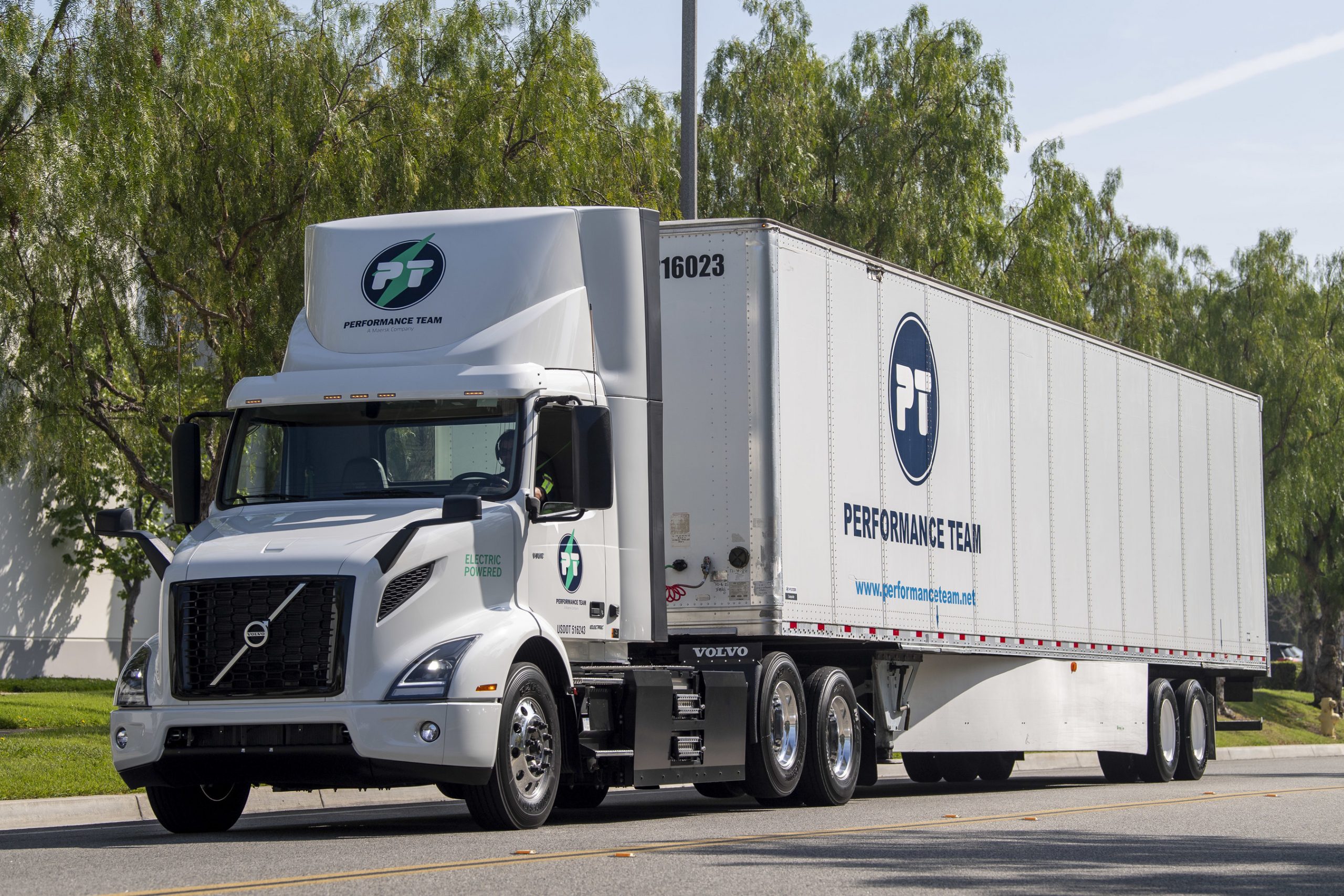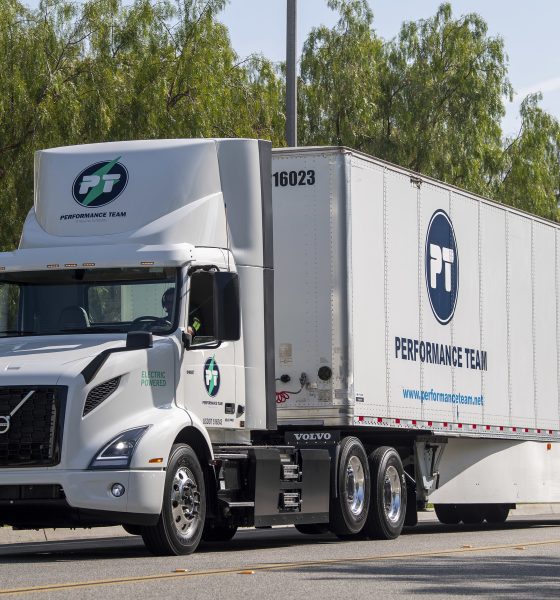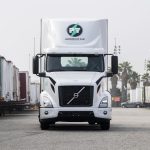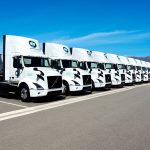

News
Volvo Trucks receives record order for 126 electric semis from Maersk-owned Performance Team
Volvo Trucks North America announced today that it received its largest global order of Class 8 electric semi-trucks with Maersk-owned Performance Team. The Maersk entity added 110 units to its order, making a commitment to purchase 126 Volvo VNR all-electric trucks after an initial order in Q3 2021 for 16 VNR electric semis.
Volvo said in a release Performance Team will begin operations in Q2 2022 in its Southern California fleet operations serving port drayage and warehouse distribution routes. Performance Team issued another order for 110 additional trucks in an effort “to scale its zero-tailpipe emission freight logistics fleet in 2022.” Volvo’s VNR all-electric semi-trucks will make their way to Performance Team in Q1 2023.
“Volvo Trucks, in partnership with our dealer TEC Equipment, is excited to continue growing our collaboration with Maersk on its fleet sustainability goals and commends the organization’s scaled investments in electromobility solutions,” Peter Voorhoeve, President of Volvo Trucks North America, said in a statement. “Incredibly, this is the second time in less than a year that Volvo Trucks has had the opportunity to announce that Performance Team – A Maersk Company, has placed the largest order of Volvo VNR Electrics to date, which underscores their organization’s firm commitment to reducing its carbon footprint.”
Maersk is the world’s largest integrated container logistics company, but is also leading a variety of new strategies to improve sustainability across its supply chain. CEO or Ocean & Logistics at A.P. Moller – Maersk, Vincent Clerc, said sustainability is important to customers now, and the company is working to oblige with the important requests of consumers and the environment.
- The Volvo VNR Electric model has been designed as a sustainable transportation solution for fleet operators supporting local and regional distribution, pickup and delivery, and food and beverage distribution.
- A lineup of Volvo VNR Electric trucks on the lot at TEC Equipment Fontana being prepared for delivery to Performance Team – A Maersk Company to operate in its Southern California fleet operations.
“Our customers are looking for tangible actions on sustainable supply chains – not just conceptual. With this in mind, we move decisively toward building an end-to-end, landside decarbonization offering for our customers – in line with our target to extend Maersk net-zero efforts to all transport modes in our global operation,” Clerc said. “These investments in our North America network will generate valuable experience for the continued journey towards similar customer offerings across the globe.”
Volvo Trucks’ largest West Coast dealership, TEC Equipment, facilitated the “landmark order.” The dealership locations in La Mirada and Fontana will support Performance Team in maximizing the uptime of the Volvo VNR fleets, Volvo said. The two TCE Equipment locations are suitable for any maintenance the VNR semis might need, as the service teams have been trained and equipped to perform any battery-electric truck maintenance needs for customers.
The VNR semi packs 275 miles of operational range. With a 250 kW charging capability that enables 80 percent charge in 90 minutes for the six-battery package or just an hour for the four-battery configuration, there won’t be much time to wait around as the truck will likely be fully charged after being loaded with goods.
I’d love to hear from you! If you have any comments, concerns, or questions, please email me at joey@teslarati.com. You can also reach me on Twitter @KlenderJoey, or if you have news tips, you can email us at tips@teslarati.com.

News
Tesla FSD fleet is nearing 7 billion total miles, including 2.5 billion city miles
As can be seen on Tesla’s official FSD webpage, vehicles equipped with the system have now navigated over 6.99 billion miles.

Tesla’s Full Self-Driving (Supervised) fleet is closing in on almost 7 billion total miles driven, as per data posted by the company on its official FSD webpage.
These figures hint at the massive scale of data fueling Tesla’s rapid FSD improvements, which have been quite notable as of late.
FSD mileage milestones
As can be seen on Tesla’s official FSD webpage, vehicles equipped with the system have now navigated over 6.99 billion miles. Tesla owner and avid FSD tester Whole Mars Catalog also shared a screenshot indicating that from the nearly 7 billion miles traveled by the FSD fleet, more than 2.5 billion miles were driven inside cities.
City miles are particularly valuable for complex urban scenarios like unprotected turns, pedestrian interactions, and traffic lights. This is also the difference-maker for FSD, as only complex solutions, such as Waymo’s self-driving taxis, operate similarly on inner-city streets. And even then, incidents such as the San Francisco blackouts have proven challenging for sensor-rich vehicles like Waymos.
Tesla’s data edge
Tesla has a number of advantages in the autonomous vehicle sector, one of which is the size of its fleet and the number of vehicles training FSD on real-world roads. Tesla’s nearly 7 billion FSD miles then allow the company to roll out updates that make its vehicles behave like they are being driven by experienced drivers, even if they are operating on their own.
So notable are Tesla’s improvements to FSD that NVIDIA Director of Robotics Jim Fan, after experiencing FSD v14, noted that the system is the first AI that passes what he described as a “Physical Turing Test.”
“Despite knowing exactly how robot learning works, I still find it magical watching the steering wheel turn by itself. First it feels surreal, next it becomes routine. Then, like the smartphone, taking it away actively hurts. This is how humanity gets rewired and glued to god-like technologies,” Fan wrote in a post on X.
News
Tesla starts showing how FSD will change lives in Europe
Local officials tested the system on narrow country roads and were impressed by FSD’s smooth, human-like driving, with some calling the service a game-changer for everyday life in areas that are far from urban centers.

Tesla has launched Europe’s first public shuttle service using Full Self-Driving (Supervised) in the rural Eifelkreis Bitburg-Prüm region of Germany, demonstrating how the technology can restore independence and mobility for people who struggle with limited transport options.
Local officials tested the system on narrow country roads and were impressed by FSD’s smooth, human-like driving, with some calling the service a game-changer for everyday life in areas that are far from urban centers.
Officials see real impact on rural residents
Arzfeld Mayor Johannes Kuhl and District Administrator Andreas Kruppert personally tested the Tesla shuttle service. This allowed them to see just how well FSD navigated winding lanes and rural roads confidently. Kruppert said, “Autonomous driving sounds like science fiction to many, but we simply see here that it works totally well in rural regions too.” Kuhl, for his part, also noted that FSD “feels like a very experienced driver.”
The pilot complements the area’s “Citizen Bus” program, which provides on-demand rides for elderly residents who can no longer drive themselves. Tesla Europe shared a video of a demonstration of the service, highlighting how FSD gives people their freedom back, even in places where public transport is not as prevalent.
What the Ministry for Economic Affairs and Transport says
Rhineland-Palatinate’s Minister Daniela Schmitt supported the project, praising the collaboration that made this “first of its kind in Europe” possible. As per the ministry, the rural rollout for the service shows FSD’s potential beyond major cities, and it delivers tangible benefits like grocery runs, doctor visits, and social connections for isolated residents.
“Reliable and flexible mobility is especially vital in rural areas. With the launch of a shuttle service using self-driving vehicles (FSD supervised) by Tesla in the Eifelkreis Bitburg-Prüm, an innovative pilot project is now getting underway that complements local community bus services. It is the first project of its kind in Europe.
“The result is a real gain for rural mobility: greater accessibility, more flexibility and tangible benefits for everyday life. A strong signal for innovation, cooperation and future-oriented mobility beyond urban centers,” the ministry wrote in a LinkedIn post.
News
Tesla China quietly posts Robotaxi-related job listing
Tesla China is currently seeking a Low Voltage Electrical Engineer to work on circuit board design for the company’s autonomous vehicles.

Tesla has posted a new job listing in Shanghai explicitly tied to its Robotaxi program, fueling speculation that the company is preparing to launch its dedicated autonomous ride-hailing service in China.
As noted in the listing, Tesla China is currently seeking a Low Voltage Electrical Engineer to work on circuit board design for the company’s autonomous vehicles.
Robotaxi-specific role
The listing, which was shared on social media platform X by industry watcher @tslaming, suggested that Tesla China is looking to fill the role urgently. The job listing itself specifically mentions that the person hired for the role will be working on the Low Voltage Hardware team, which would design the circuit boards that would serve as the nervous system of the Robotaxi.
Key tasks for the role, as indicated in the job listing, include collaboration with PCB layout, firmware, mechanical, program management, and validation teams, among other responsibilities. The role is based in Shanghai.
China Robotaxi launch
China represents a massive potential market for robotaxis, with its dense urban centers and supportive policies in select cities. Tesla has limited permission to roll out FSD in the country, though despite this, its vehicles have been hailed as among the best in the market when it comes to autonomous features. So far, at least, it appears that China supports Tesla’s FSD and Robotaxi rollout.
This was hinted at in November, when Tesla brought the Cybercab to the 8th China International Import Expo (CIIE) in Shanghai, marking the first time that the autonomous two-seater was brought to the Asia-Pacific region. The vehicle, despite not having a release date in China, received a significant amount of interest among the event’s attendees.










